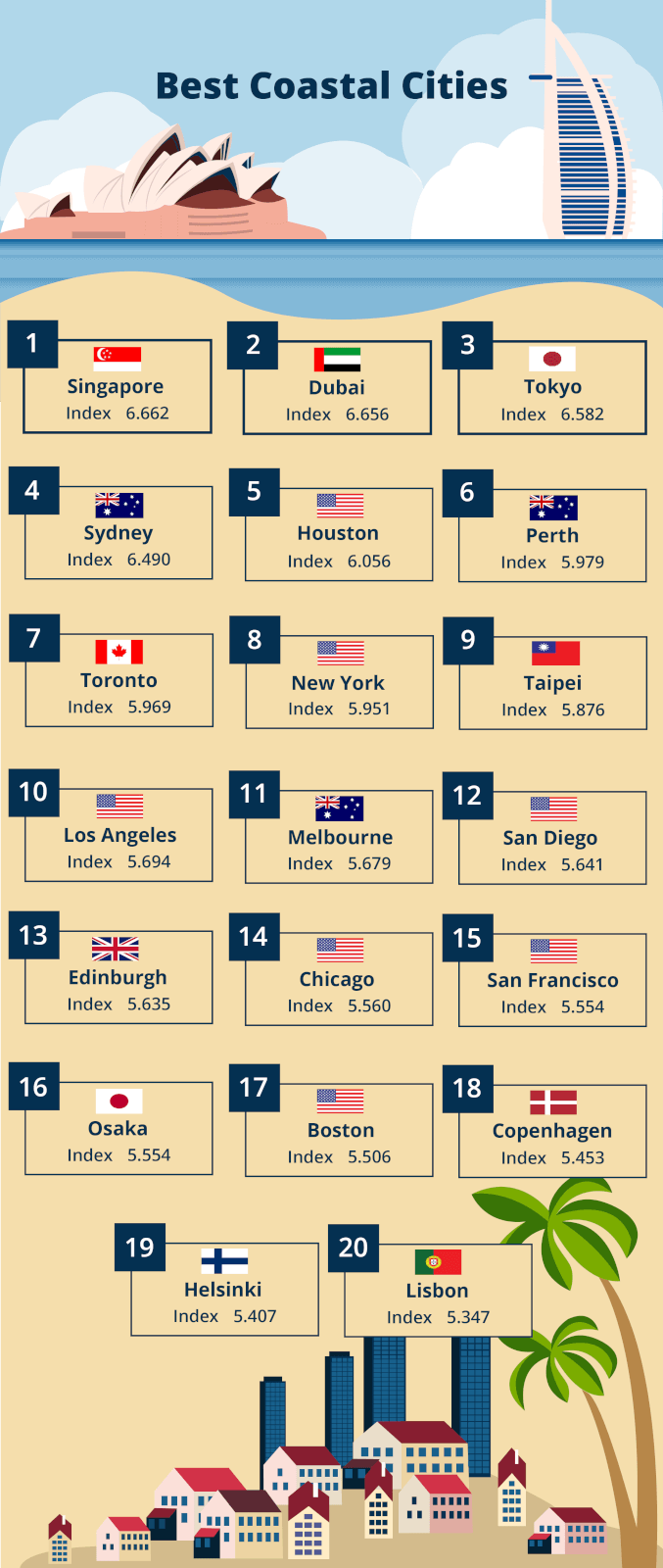The Burrow

Every year, the coast draws thousands of us away from city centres with the promise of a slower pace of life, and easier access to nature. Whilst coastal cities have so many benefits to them, if you’re considering making the move, it’s also important to take into consideration things like access to amenities and monthly salaries, so you can still enjoy a great quality of life.
As experts in helping consumers look for home loans while on their home-buying journey, we decided to take a look at a variety of coastal cities all over the world, and see where’s best to live, based on a range of factors including unemployment rates, average salaries, healthcare quality, interest rates and more.
A nation’s average interest rate can be looked at as a key cost of living measure, and plays a big part in the affordability of housing in said nation, along with other cost of living pressures.
A higher average interest rate can be particularly important in coastal cities, where property is often more expensive due to the perceived desirability of those markets, since higher rates and large mortgage sizes can significantly impact affordability. When looking to purchase, particularly in Australia, comparing your options for home loans can help you to identify whether a reasonable home loan interest rate is available and look for a deal that is best for your circumstances.
So, whether you’re considering packing up and moving to the shores, or just want to book a beach break, read on to discover the best coastal cities the world has to offer.

To view results for each individual ranking factor for the above cities, please click here.
Coming in first place, Singapore is renowned for offering an excellent quality of life, and part of the reason why it scores so well is because it has the third-lowest rate of unemployment (2.25%), and low interest rates.
If you want to live right by the beach, then you’ve got loads of places to choose from. Siloso beach is surrounded by cute cafes and hip eateries, whereas Palawan boasts some of Singapore’s best swimming areas, with tranquil waters.
Commonly referred to as the playground of the rich, Dubai comes in a very respectable second position, due to its incredibly high standard of living. Not only that, but it has the second-lowest unemployment rate on our list (1.6%), the third-lowest crime rate levels, and the fifth-highest number of attractions.
JBR beach is undoubtedly the most well-known. The biggest in Dubai, whilst some sections are private for hotels, the vast majority is open for everyone to enjoy. Alternatively, you can head to one of Dubai’s newest beach developments, La Mer, which also offers lots of places to eat and shop, or Kite beach for watersports.
Japan’s capital comes in third place, with its high healthcare quality, low unemployment rate, and sheer number of things to do (with 12,131 attractions!) making it one of the best coastal cities in the world to move to.
Whilst Tokyo might be more well-known for the hustle and bustle of its city centre, there are actually loads of beautiful beaches on the outskirts that you can move to. Southern Beach Chigasaki is popular with both surfers and swimmers, and on a clear day, you can see Mount Fuji; whereas Atami Sun Beach in Shizuoka is an hour and a half out of the city, and is also home to tranquil hot springs.
The first Australian city to feature on our list, Sydney is famed worldwide for its beautiful beaches. Bondi Beach might be the most well-known, and it’s certainly one of the closest to Sydney’s city centre, but there are so many more shores to discover, too.
Hop on a ferry and head over to Manly Beach for its gorgeous golden sands, Shelly Beach for some of the best sunset views, or Balmoral Beach, which is particularly popular with families.
In terms of practicalities, Sydney has a high quality of healthcare (sixth on our list), and the 14th highest monthly salary after tax, at US$4,212.50 (AU$6,697.88).
Wrapping up our list of top five coastal cities is Houston, located on the edge of the Gulf of Mexico. For a slower pace of life, head out of the city centre to the suburbs, to the likes of East Beach in Galveston, which isn’t just home to pure white sands, but the annual American Institute of Architects Sandcastle Competition (perfect if you like sandcastles!).
Alternatively, Stewart Beach is perfect for families with its calm waters, pavilion, and playground; or Bryan Beach, which is the ideal choice if you don’t want to leave the party scene behind.
With Houston’s monthly salary after tax being the seventh-highest on the list, at US$5,020.60 (AU$7,982.75), and unemployment rates fairly low, at 3.89%, it’s clear to see why you might choose to move here.
Whilst Houston came on top in America, in fifth position overall, there are lots of other US cities that feature on our list. New York came in eighth place overall, with Long Island a popular neighbourhood for people who want to move to the coast, but still have easy access to city life.
Los Angeles came in at 10th place, with its high monthly salary helping to attract people to move there (in addition to the likes of the gorgeous Malibu, Santa Monica, Venice Beach, and more!).
San Diego, Chicago, and San Francisco all make it into the top 15, due to their relatively low levels of unemployment, and interest rates – not to mention, some of the highest monthly salaries on the list. So, whether you prefer east or west coast, there are lots of great coastal cities in the US you can move to.
Moving eastwards to Europe, Edinburgh is the first city to make it on the list, in 13th place overall; followed by Copenhagen, Helsinki and Lisbon, in positions 18-20.
Cramond, Granton, and Portobello are just three well-loved beaches in Edinburgh, all offering a slower pace of life, whilst being just a few miles away from the city centre. Portobello in particular, is popular with locals and tourists, so if you do still crave the hustle and bustle, this can be the better area to move to.
Copenhagen’s Amager Strandpark – a beautiful sandy stretch of beach – is just a few minutes away from the city centre on the metro; and not far from Sweden. Not only will you be able to see the bridge that connects the two countries from here, but also the Turning Torso building in Malmö.
As Stephen Zeller, General Manager of Money at Compare the Market Australia states: “No matter where you are in the world, if you feel the coast calling you, rest assured that there are so many great cities that offer sandy shores and a slower pace of life, without compromising on job opportunities and high salaries, as well as easy access to amenities and healthcare facilities.
“Make sure that before moving, you consider the interest rates of the country you’d like to move to so that you can be prepared to meet financial obligations in the event you take out a home loan. Once you get to this stage, keep in mind that even a small variation in interest rates can be the difference between flourishing or flailing when it comes to making repayments. Comparing options can help you with choosing an option that is appropriate for you and your circumstances.”
So, if you do decide to pack up and move, particularly to Australia, then don’t forget to compare home loans to make your transition into a new city as affordable as possible.
This dataset ranks 47 different coastal cities across the world, based on living conditions and affordability. To do this, 9 different factors were used. Once the data for the factors was collected, the factors were then normalised, to provide each factor with a score between 0 and 1. The normalised values were then summed, to give each city a total score out of 9. The cities were then ranked from highest to lowest, based on their total scores.
The factors used are as follows:
The factors were indexed as follows:
Data gathered is correct as of 20/10/2022. The most recent data possible was used in compiling this dataset. To do this, some factors had to utilise data from previous years. All price data provided was given in AUD, USD, and GBP. This data was collected from Google’s currency converter, with the following conversion rates being used: 1 USD = 1.59 AUD, 1 USD = 0.9 GBP.